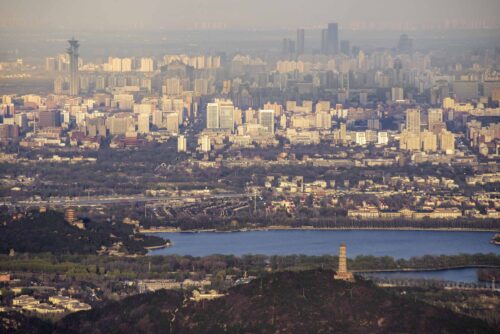Retracing the Long March: A red pilgrimage on motorbike
Last summer, Mads Vesterager Nielsen set out on a 6,500-kilometer journey on his motorbike from Ruijin, Jiangxi to Yan’an, Shaanxi, retracing the movement of the Red Army from 1934 to 1935.
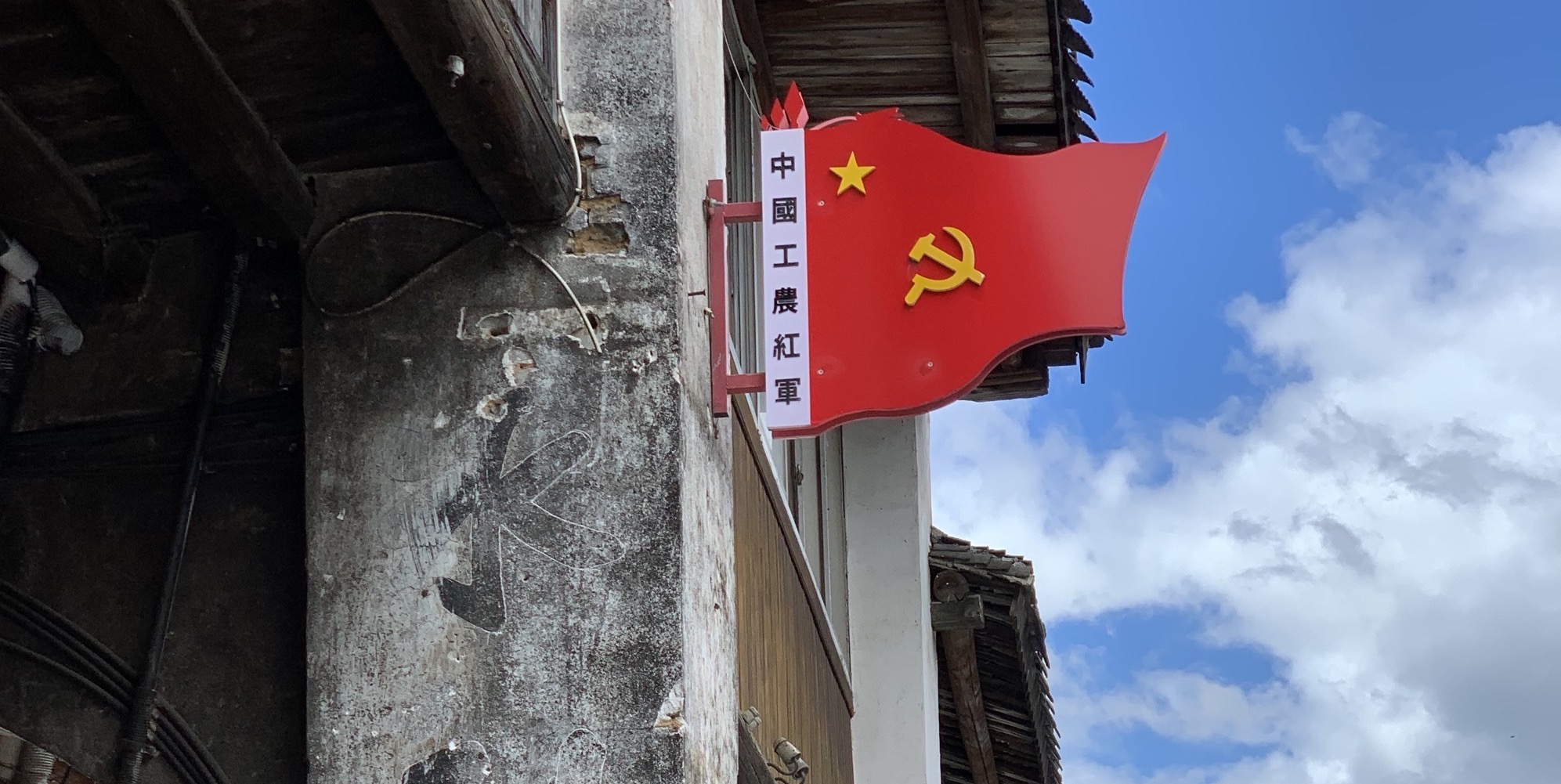
“Now the Long March is your march,” the red revolutionary instructor says, lacking no amount of melodrama.
I am in Ruijin in eastern China’s Jiangxi province, one of the famed destinations for red tourism in China. These days, business is booming. In the year leading up to the centenary of the founding of the Chinese Communist Party (CCP), tourists flocked here to take part in weekend retreats, where they learned about revolutionary spirit and the leaders who graced this area in the 1930s.
In Ruijin, also known as China’s “cradle of revolution,” Communist leaders established a base in 1931, where they tested ideas of socialism and revolution. It is also from here that Communist forces broke out in 1934, as Nationalist forces commanded by Chiang Kai-Shek (蒋介石 Jiǎng Jièshí) surrounded the area (in a maneuver devised by Chiang’s German military advisor, Hans von Seeckt). The Communists’ ensuing journey north would become a centerpiece in the mythos of the party and the People’s Republic, christened “The Long March.”
The Long March was actually a series of marches led by various people, but the most famous of these was the march of the First Army, commanded by Máo Zédōng 毛泽东 (with Zhōu Ēnlái 周恩来 and Dèng Xiǎopíng 邓小平 in his company). The starting point was at the bank of the Yudu River, where Communists broke through Nationalist lines in 1934. There is a platform here overlooking the river, with a giant map featuring a multitude of colored arrows going across China. The 12,500-kilometer route — undertaken from October 1934 to October 1935 — is there. Today, the Long March is synonymous with struggle: the struggle for a better society, a better country. It is regularly used as a metaphor for everything from weathering trade wars to interstellar rocket systems.
In August 2020, I rode my trusty Suzuki GN-125 motorbike — which I’ve nicknamed the “little black yak” — along the Long March route, from Ruijin all the way to the revolutionary capital of Yan’an in Shaanxi, following the footsteps of Communist ghosts. (It only took me 6,500 kilometers, owing to more straightforward roads.) I encountered local historians, TikTok livestreamers, and a Catholic priest. Whatever else, you’ll have to read on.

Caves and rivers
Jiangxi-Hunan-Guangxi

It is hot as hell, and I sweat so much that my iPhone can’t recognize me through Face ID. In Ruijin, you can find all the precursors to the institutions of the contemporary Chinese state, like the people’s consultative conference, Xinhua News Agency, and ministries of government. These mud-walled offices attract a myriad of public employees every year.
In a roadside restaurant, I meet a mother and her daughter. “I want to be a soldier when I grow up,” the young girl in a mint green dress says. Her mother smiles and laughs. “She has seen the red pilgrims pass by outside,” she says, nodding toward the road.
Last year, CNN reported that some 100 million red tourists visited “red revolutionary areas” that year. Leading up to the centenary of the Chinese Communist Party, Chinese travel and ticket platform Ctrip launched more than 100 unique routes for “red pilgrims,” and predicted that this campaign would attract around 50 million people.
It is not known when the first “red pilgrimages” took place, but they peaked in popularity during the Cultural Revolution (1966-1976), when young people flocked to the sites of Communist leaders. Some are even reported to have walked the entirety of the Long March. The experience borrows from Tibetan and Daoist ideas of spiritualism: you walk to learn and to transform yourself.
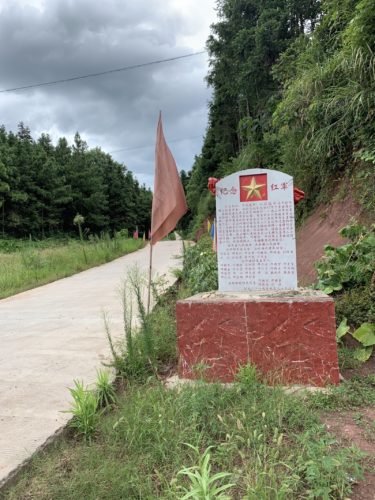
From Ruijin, I head west, toward Hunan province. Along the way, there are exhibitions hosted by locals about anything and everything related to the march. On a hilltop, a machine gun nest has been preserved. At another stop, a story is relayed about how Mao Zedong broke a ceramic bowl in two to signal that communists would share everything — even bowls and cutlery.

“MAO ZEDONG LEADS ARMIES LIKE A GOD!” The sound of the revolutionary tune “Crossing the Chishui Four Times” rattles out of the mountain cave like machine gun fire. I bring the motorbike to a halt. At first glance, this cave looks like the opening of a mine shaft, but now I see the red banners and yellow Chinese characters that invite passersby inside.
It’s here, in a single huge cave complex, that a man named Mr. Liu lives. “I always wanted to take care of this place,” he says. He worked as a clerk in the nearby village, but when he retired he moved into the cave, alone, and made up his mind to single-handedly restore the 10-plus kilometers of natural cave formations. “This is our history. My dream is that this place may one day achieve the status as a red tourist destination,” he says. It’s here, after all, that 5,000 Communist soldiers hid with their top leaders.
When I arrive, Liu has just made contact with the government in order to officially turn the place into a tourist site. He takes me on a tour into the depths of the mountains, where he has collected porcelain shards and bullet cartridges from the troops that hunkered down here in 1934.
“Be careful not to disturb our friends.” He points the flashlight upward at the ceiling, where hundreds of black bats shiver in the light. Not exactly what I wanted to see in the middle of a pandemic. “They are harmless,” Mr. Liu assures me. But I move through quickly nonetheless.
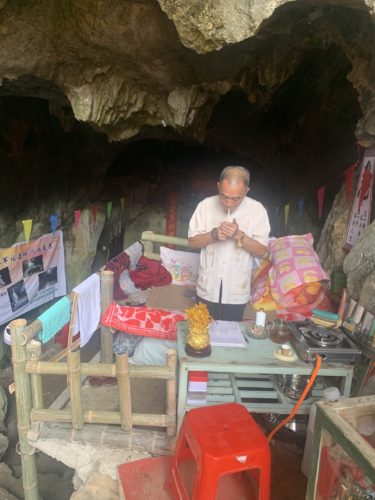
Liu is 70 years old, and has lived alone in this cave for three years, making stone staircases and hoisting steel ropes into the depths of the mountain rock.
“My grandson got a place at a university in Beijing,” he says with a smile. The cave suddenly drops into a chasm with no safety railing, and I can’t see the bottom with my flashlight. “I have also been to Beijing. But that’s a long time ago. When I was 16, it must have been 1965. It’s the only time I’ve been there. It was very special because I met Chairman Mao.” At the bottom of the cave are still porcelain shards and the shattered remains of brick and mortar kitchens. “We were a group of children whose fathers and mothers were all revolutionaries. My father lost his right leg fighting the Japanese during the war.”
In the heart of the mountain there are no sounds. And no cell phone signal. It is dark, and the cave rises as big as a cathedral hall. It is only me and Mr. Liu — and perhaps some ghosts. “The Nationalists attacked and killed 2,000 here in the tunnels,” he says.
“My children do not understand why I do it, but at the same time they think it is commendable. They have never visited.”
“You love red songs?” I say in an awkward attempt to lighten the mood.
“When I listen to them, I’m not lonely. It reminds me of why I do this.”
Mr. Liu asks me to rest and spend the night in the cave, but I have to move on.

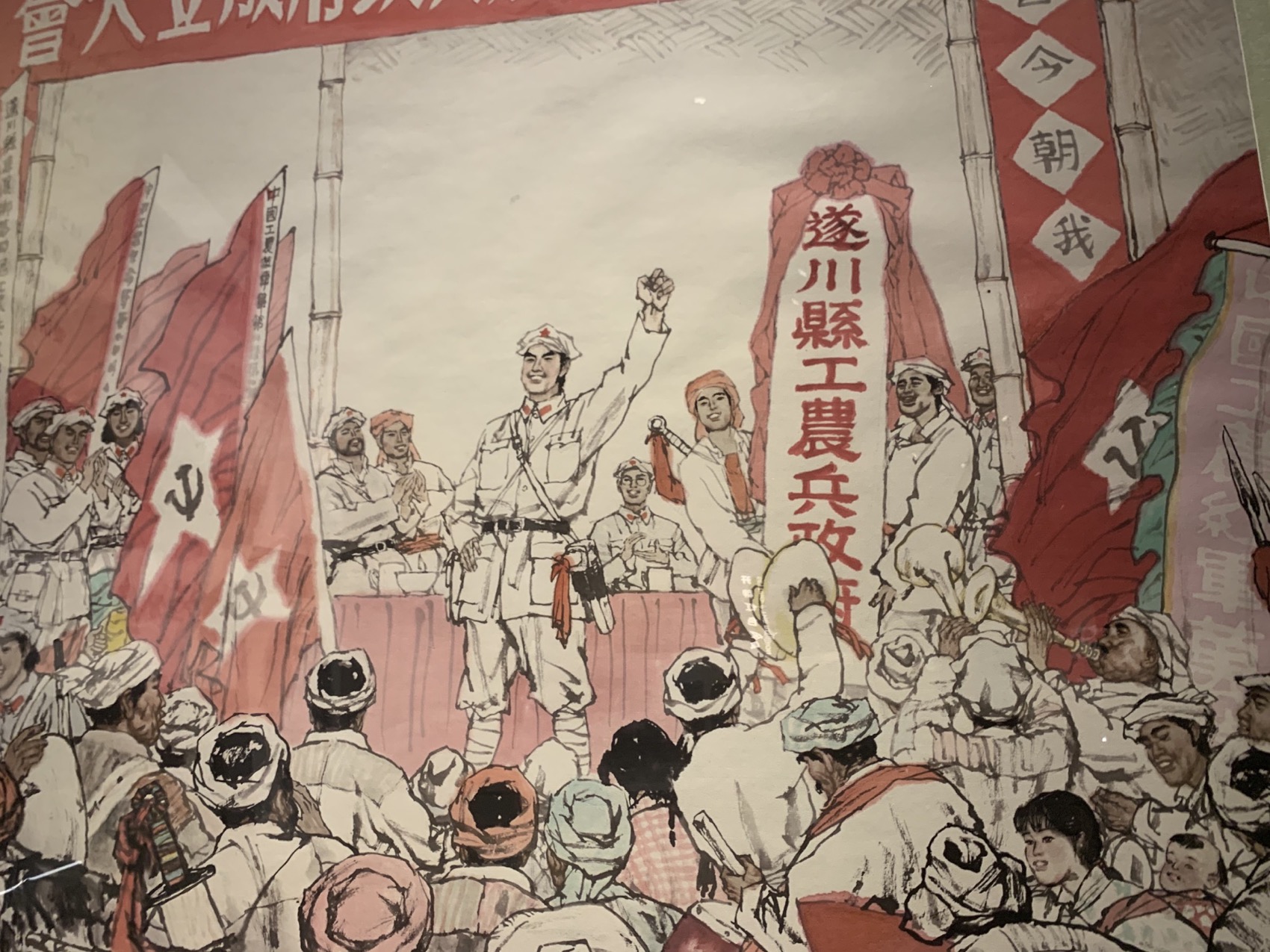
I cross into Guangxi, where the landscape changes to sharp limestone mountains covered with plush greenery and bamboo forests. The roads here are muddy and cut through thick trees. I follow it to Xiang Jiang — Fragrant River.
I’ve just checked into my hotel when I hear hard knocks at my door. “Open up!” a voice commands from the other side. I’ve only just stepped out of the shower after a full day and night of driving.
Five Chinese policemen are standing outside my door.
“Come on in,” I say, and give them all cigarettes as they enter. They glance at each other, not quite sure how to proceed. I show them my Chinese health code app. “You’re OK?” one of them asks gingerly. He tightens his blue surgical mask.
“I’m having a great time,” I say.
They look at each other before the senior officer nods and the mood loosens. “Oh I was so nervous when I heard we were going to see a foreigner, but you don’t have COVID,” one of the young officers laughs.
“Tak, tak, tak?” one of the others says. “Is that not what you say in your language?”
I see that he has a translator app open on his smartphone. “Denmark — Hans Christian Andersen, LEGO, and cookies, right?” he says.
The officers puff Chinese cigarettes in my small hotel room while we chitchat. When they’re ready to leave, they tell me to rest well. “It’s best not to go out tonight.”
The next day, I race along jungle roads between the characteristic limestone mountains. I reach a spot where the Communists, trying to cross the river, lost over half of their men (though exact numbers vary) in the Battle of the Xiang River.
At the battle, the Moscow-trained wing of the Party leadership — Bó Gǔ 博古 and Otto Braun (who was known by his Chinese name, Lǐ Dé 李德) — tried to lead their forces west. Nationalist and local warlords hard-fortified positions on each side of the river, creating a formidable obstacle, with defenses at multiple spots along the river. The disaster left the First Red Army reeling, and weakened the command of Bo and Braun, and ultimately secured the leadership of “local communists” not under direction of the Comintern. To this day, the Fragrant River is sometimes referred to as the “red river” because it was said to be colored red by the blood of soldiers.
I drive back into Hunan before pitching my tent on a riverbank and spending the night in the hot tropical night. The next day, the road runs through small villages surrounded by spring green rice fields, where ducks, geese, and pigs are sold at markets along the roads.
I turn north into rural Hunan and camp on a riverbank close to Tongdao, where CCP leaders met and regrouped after the Xiangjiang disaster. In the border regions between Hunan and Guizhou, minority villages are nestled in the rolling hills and forest landscape. Green rice fields and bustling village markets line the road to the east, and architecture from the ethnic minorities of the Miao, Yi, and Zhuang are seen from village to village.
In the days to come, I will move farther west, through some of the most difficult terrain of the Long March, as the route takes me through the mountains and valleys of Guizhou, Yunnan, and Sichuan. Come back next week to read about it.

This is Part 1 of 3 of Mads Vesterager Nielsen’s motorbike trip along the Long March route. Parts 2 and 3 are below:
Retracing the Long March: Arriving at the revolutionary capital


